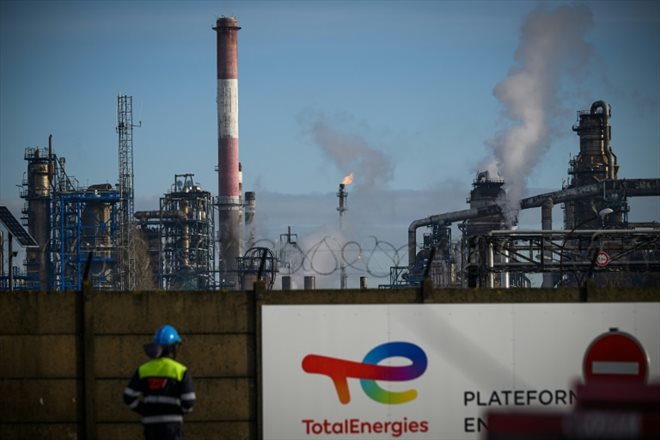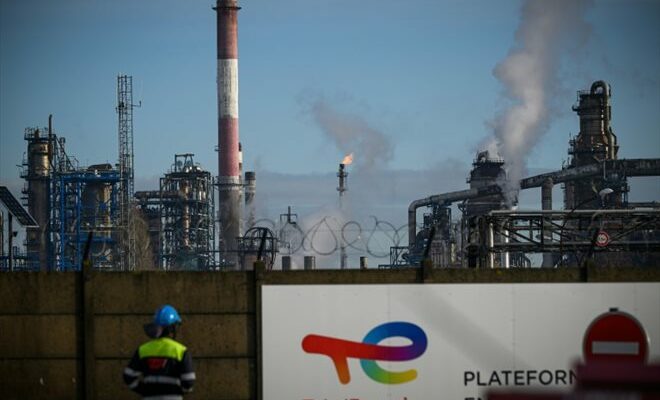The factory of the Norwegian fertilizer group Yara International in Montoir-de-Bretagne, November 30, 2023 in Loire-Atlantique (AFP/Archives/LOIC VENANCE)
A factory singled out for its dust releases, sulfuric acid or gasoline leaks, and “metal-polluted” soils. Worried about industrial pollution, elected officials and residents of the Saint-Nazaire basin (Loire-Atlantique) are demanding accountability from companies and the State.
The “fight” of Thierry Noguet, mayor of Montoir-de-Bretagne, was first fought against Yara. Based in its town, this Norwegian fertilizer manufacturer has been singled out several times for sulfuric acid leaks, and ordered in June to pay a fine for dust releases into the atmosphere.
While the mayor called for the administrative closure of this high-threshold Seveso-classified factory while awaiting work, Yara announced in November the elimination of 139 positions and its transformation into a storage site.
“As an improvement plan, they issued a brutal social plan. But if we had not made noise, it would have continued to produce and pollute,” says Thierry Noguet.
Very close to Saint-Nazaire, its commune is at the heart of a 150-year-old industrial basin, which has nearly 140 “installations classified for environmental protection” (ICPE), likely to present danger or pollution.
Chimneys, factories and hangars follow one another along the Loire, all the way to the ocean. In the surrounding towns, a study “caused a lot of talk”, says Thierry Noguet.

Employees of the Norwegian fertilizer group Yara on strike in front of the Montoir—de-Bretagne factory, November 22, 2023 in Loire-Atlantique (AFP/Archives/Damien Meyer)
In 2019, the Regional Health Observatory (ORS) highlighted an excess mortality of 28% among those under 65 in Carene (urban community of the Nazaire region and the estuary) compared to the average nationally, and an excess incidence of certain cancers.
Santé Publique France has since been contacted by the ARS to analyze “the relevance and feasibility” of an epidemiological study aimed at “identifying the contribution of industrial pollution in the occurrence of pathologies”.
An area study is underway to “refine the list of pollutants emitted” and “characterize the sources of pollution”.
– Benzene –
“Some first pointed the finger at alcohol and tobacco. But no figures say that we drink or smoke more than elsewhere. In an area marked by asbestos, residents legitimately want to know what they are exposed to,” Matthias Tavel, LFI deputy for Loire-Atlantique, told AFP.
In the historically working-class neighborhood of Méan-Penhoët, in Saint-Nazaire, “everyone knows someone who died from asbestos,” says Christian Quélard, retired maths teacher and president of the Vivre à association. Méan-Penhouët (Vamp). His father, a worker at the nearby shipyard, died of pleural cancer recognized as an occupational disease.

The factory of the Norwegian fertilizer group Yara International in Montoir-de-Bretagne, November 30, 2023 in Loire-Atlantique (AFP/Archives/LOIC VENANCE)
The association was created in 2015 to fight – without success – the installation in the neighborhood of the Rabas Protec company, using paints containing a Chrome VI compound, an anticorrosive popular in aeronautics, classified as carcinogenic and subject to authorization.
“There are several companies here that use it (…) Welding with stainless steel also releases some. Chimneys filter these releases, but with this addition, it is we who could risk indigestion”, denounces Christian Quélard.
In Donges, downstream of the Loire, Marie-Aline and Michel Leclerc, at the head of the Donges Association of Risk Zones, closely monitor the level of benzene in the air. Their house adjoins a TotalEnergies refinery classified as Seveso high threshold.
After a leak of 770,000 liters of gasoline in December 2022, the concentration of certain hydrocarbons in the air increased 20-fold over one week, according to Air Pays de la Loire.
For benzene, classified as carcinogenic and subject to regulation, the organization noted on two measurement sites a “probable exceedance of the quality objective”, calculated over the year. However, no site crossed the average limit value.
– Monitoring –
On February 20, the refinery was shut down after teams detected “corrosion”. The CGT also mentions “leaks”. According to the union, these do not present a risk to the site’s environment.

The TotalEnergies refinery in Donges, January 20, 2023 in Loire-Atlantique (AFP/Archives/LOIC VENANCE)
Maintenance operations are underway, according to the refinery, which also claims to have put in place “very substantial means to ensure the safety of its installations (…) of the order of 50 million euros per year” .
In recent months, the number of checks “has increased by 50% on all ICPEs and even more so on Seveso”, the sub-prefect of Saint-Nazaire, Éric de Wispelaere, told AFP.
To those who accuse the prefecture of “complacency” towards industrialists who provide jobs, he responds: “There are no concessions from the State on public health issues. This would not be tolerable . We apply the laws and nothing else.”
In February, the prefecture estimated in a decree that the “levels of atmospheric emissions” from Chantiers de l’Atlantique justified “additional supervision”.
The prefecture notably enjoins the manufacturer to set up an “environmental monitoring program” including “outdoor air quality measurements in the vicinity of the establishment”, which must relate in particular to certain hydrocarbons and metals, including Chrome VI.
This decree “is a logical extension of our actions to monitor our activity and comply with regulations, in collaboration with the competent administrative authorities”, the company responded to AFP.
– Metals –
These days, the mayor of Trignac, a town bordering Saint-Nazaire, notes “advances”: “Until now there was a vacuum, industrialists did a little bit what they wanted (…) That associations, elected officials, are becoming aware, training on these issues, so the pressure will be greater,” says Claude Aufort, also vice-president of Carene in charge of ecological transition.
It was in his commune that the steel hulls assembled in the shipyards were forged at the end of the 19th century. “If you scratch the earth, it’s polluted with metals. We’re talking about an environment, it goes beyond air quality,” says the mayor.
In Méan-Penhouët, a square closed in November after the detection of heavy metals in the ground. In the same district, analyzes carried out by Vamp on several wells revealed arsenic levels ten times higher than the quality limit for drinking water.
Warned, the ARS must carry out “additional investigations” at the end of March.
In the future, Thierry Noguet wants to apply his “3 C method”: “observe, understand, correct”. “If we see, we understand but we do nothing, we tend towards the 5 Cs: ‘it’s stupid but it’s like that’. It’s the bad option.”
© 2024 AFP
Did you like this article ? Share it with your friends using the buttons below.




